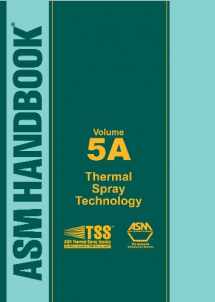
ASM Handbook: Thermal Spray Technology
Book details
Summary
Description
This addition to the ASM Handbook series is co-published by the Thermal Spray Society and ASM International. Volume 5A is a replacement for the Handbook of Thermal Spray Technology, edited by J.R. Davis (ASM, 2004). The volume provides an introduction to modern thermal spray processes including plasma spray, high velocity oxy-fuel, and detonation gun deposition; and a description of coating properties, their wear, corrosion, and thermal barrier characteristics. Principles, types of coatings, applications, performance, and testing/analysis also are covered. The Handbook serves as an excellent introduction and guidebook for those new to thermal spray. A greatly expanded selection of applications includes examples and figures from various industries, including electronics and semiconductors, automotive, energy, and biomedical. Emergent thermal spray market sectors such as aerospace and industrial gas turbines, and important areas of growth such as advanced thermal barrier materials, wear coatings, clearance control coatings, and oxidation/hot corrosion resistant alloys also are reviewed. Thermal spray coatings offer industry the opportunity to improve the performance and lower the costs of manufacturing equipment and processes as well as products produced. The major advantages of thermal spray processes include the ability to produce coatings of an extremely wide variety of materials (including ceramics, metals, cermets, and some polymerics), to deposit those materials without significantly heating the substrate and thus without changing the dimensions or properties of the component being coated, and, in most cases, to strip a worn coating and replace it with a new one. More reliable and robust equipment technology, along with improved particle diagnostics, have helped to move the thermal spray process from guesswork to science, giving designers and end users more confidence in the long-term manufacturing capabilities of thermal spray processes. The key to future growth will be environmental barrier coatings for applications using high temperature composite substrates that surpass the operating limits of superalloys and advanced high temperature ceramics for insulation purposes.


We would LOVE it if you could help us and other readers by reviewing the book
Book review



